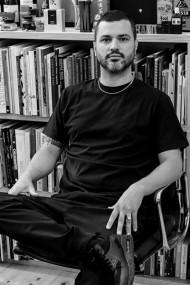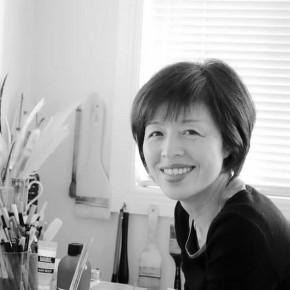誠に勝手ながら、2015年12月28日(月)~2016年1月10日(日)まで、メール返信などの対応業務をお休みとさせていただきます。
ご不便をおかけいたしますが、何卒ご容赦下さいますようお願い申し上げます。
誠に勝手ながら、2015年12月28日(月)~2016年1月10日(日)まで、メール返信などの対応業務をお休みとさせていただきます。
ご不便をおかけいたしますが、何卒ご容赦下さいますようお願い申し上げます。
2016年10月末から11月初旬にかけて、イタリアからルカ・バルチェローナを迎え、カリグラフィーワークショップを開催します。
これまでにも個人的な旅行で来日されていますが、ワークショップ開催のためには初来日です。今回は東京会場のみ、「Ruling Pen Writing」( 2日コース)と「Black Letter & Flat Brush Writing」( 4日コース)の2講座(通訳付き)を開催予定です。
ルカ・バルチェローナの紙上だけにとどまらない、躍動的でスタイリッシュな文字の表現方法や技術を直接学ぶことができる絶好の機会です。日本国内でもカリグラフィー界のみならず、デザイン界などでも、影響を受けた方やファンが多い講師ですが、世界的な活動の場の拡がりには目を見張るものがあります。インターネット上の画像で講師の作品を見て憧れていた皆さんに、ぜひ直にルカ・バルチェローナの文字アートに触れていただきたいと願っています。
講座内容・募集の詳細等については、これから随時ウェブサイトでお知らせしていきますので、ご確認ください。
< 講師プロフィール>
 Luca Barcellona ルカ・バルチェローナ
Luca Barcellona ルカ・バルチェローナ
1978年生まれ。イタリアのミラノにスタジオを持つグラフィックデザイナー、カリグラファー。文字は彼の創作活動において最も重要な要素である。Associazione Calligrafica Italianaにてカリグラフィーの教鞭をとるとともに、アメリカ、オーストラリア、ブラジル、ドイツなど世界各地でワークショップの講師を務める。その活動が示す通り、文字と言葉に関わる伝統的芸術の手書き技術をデジタル時代の表現手段と共存させている。2003年に、Rae Martini、Marco Klefischと、カリグラフィーを含む手書き文字とイラストのライブパフォーマンス集団Rabel Inkを立ち上げる。2009年には、スイスのカリグラファーKlaus-Peter Schäffelと共に、スイス国立博物館において、1569年に作られた大きな地球儀を、当時と同じ道具(羽ペン・自然素材で作られたインク)を使ったカリグラフィーで、原作に忠実に複製する作業の実現に寄与した。文字のデザイン依頼を受けたブランドとして、Carhartt、Nike、Mondadori、Zoo York、Dolce & Gabbana、Sony BMG、Seat、Volvo、Universal、Eni、Mont Blanc、Wall Street Instituteなどが挙げられる。また、最近参加した展示には、プラハで開催された「Stuck on the City」、ドイツのCarhartt Galleryで開催された「Don't Forget To Write」がある。多くの個別のプロジェクトへの参加と同様に、彼の作品は多くの出版物に登場している。自身の服飾ブランドLuca Barcellona Gold Seriesを2010年に立ち上げ、最近では初の単行本である『Take Your Pleasure Seriously』を彼自身がメンバーを務めるLazy Dog Press社より刊行している。彼の文字デザインに対する取り組みは、グラフィティの経験から伝統的なカリグラフィーへと導かれ、更に大きな壁に描くウォールペイント、タイポグラフィーそして活版印刷まで広がっている。
講師ウェブサイト
http://www.lucabarcellona.com/
『ルカ・バルチェローナ「カリグラフィーWS」2016 詳細・申込み要項のご案内』をNewsのページにアップしました。
2016年10月末から11月初旬にかけて、イタリアからルカ・バルチェローナを迎え、カリグラフィーワークショップを開催します。
これまでにも個人的な旅行で来日されていますが、ワークショップ開催のためには初来日です。今回は東京会場のみ、「Ruling Pen Writing」( 2日コース)と「Black Letter & Flat Brush Writing」( 4日コース)の2講座(通訳付き)を開催予定です。
ルカ・バルチェローナの紙上だけにとどまらない、躍動的でスタイリッシュな文字の表現方法や技術を直接学ぶことができる絶好の機会です。日本国内でもカリグラフィー界のみならず、デザイン界などでも、影響を受けた方やファンが多い講師ですが、世界的な活動の場の拡がりには目を見張るものがあります。インターネット上の画像で講師の作品を見て憧れていた皆さんに、ぜひ直にルカ・バルチェローナの文字アートに触れていただきたいと願っています。
講座内容・募集の詳細等については、これから随時ウェブサイトでお知らせしていきますので、ご確認ください。
< 講師プロフィール>
 Luca Barcellona ルカ・バルチェローナ
Luca Barcellona ルカ・バルチェローナ
1978年生まれ。イタリアのミラノにスタジオを持つグラフィックデザイナー、カリグラファー。文字は彼の創作活動において最も重要な要素である。Associazione Calligrafica Italianaにてカリグラフィーの教鞭をとるとともに、アメリカ、オーストラリア、ブラジル、ドイツなど世界各地でワークショップの講師を務める。その活動が示す通り、文字と言葉に関わる伝統的芸術の手書き技術をデジタル時代の表現手段と共存させている。2003年に、Rae Martini、Marco Klefischと、カリグラフィーを含む手書き文字とイラストのライブパフォーマンス集団Rabel Inkを立ち上げる。2009年には、スイスのカリグラファーKlaus-Peter Schäffelと共に、スイス国立博物館において、1569年に作られた大きな地球儀を、当時と同じ道具(羽ペン・自然素材で作られたインク)を使ったカリグラフィーで、原作に忠実に複製する作業の実現に寄与した。文字のデザイン依頼を受けたブランドとして、Carhartt、Nike、Mondadori、Zoo York、Dolce & Gabbana、Sony BMG、Seat、Volvo、Universal、Eni、Mont Blanc、Wall Street Instituteなどが挙げられる。また、最近参加した展示には、プラハで開催された「Stuck on the City」、ドイツのCarhartt Galleryで開催された「Don't Forget To Write」がある。多くの個別のプロジェクトへの参加と同様に、彼の作品は多くの出版物に登場している。自身の服飾ブランドLuca Barcellona Gold Seriesを2010年に立ち上げ、最近では初の単行本である『Take Your Pleasure Seriously』を彼自身がメンバーを務めるLazy Dog Press社より刊行している。彼の文字デザインに対する取り組みは、グラフィティの経験から伝統的なカリグラフィーへと導かれ、更に大きな壁に描くウォールペイント、タイポグラフィーそして活版印刷まで広がっている。
講師ウェブサイト
http://www.lucabarcellona.com/
フェイスブックで、ずっと憧れていたYukimi Annandさん。
私は、カリグラフィーを始めて、作品を作っていくうちに、理解し難い自分の感情や感覚を、理解し難い母国語以外の言語で表現したいと思うようになりました。それは、外国語を理解するのと、感情や感覚を理解して言葉にすることが、似ていると気がついたからです。
ただ、これは私独自の表現方法なので、感覚や感情から作品にするまでのプロセスを教えてくれるお教室はなく、私自身が突き詰めていくしかありません。
そんな時に、テキスト(アルファベット)を使って複雑なテクスチャーを作っていくYukimiさんのワークをフェイスブック上でみていて、テクスチャーなのに、ラインが活きているみたい!ラインに感情があるみたい!と感銘を受けました。どうしたらこのような活きているラインができるのか、何かコツというか芯があるに違いないと感じ、いつか彼女のワークショップを受けにアメリカに行こう!と思っていました。
願いは叶いますね!日本開催で、日本語で受講できることになりました。
楽しみに待っていたその当日、日本の東京でのYukimiさんのワークショップは、穏やかにはじまりました。
「思考が腕を通り指先へ、そして道具からさらに紙へ出ていく感じで、すべて一体のような感覚にして描いていく」とおっしゃったかと思うと、体中の空気が一体に なるように深い呼吸をし、静かに描き始めました。その静かだけどリズミカルなデモストレーションをみていると、まるでYukimiさんの頭の中にあるものが体を通り、ラインとしてこの瞬間に、紙の上に現れている映像かのように思えて、時を忘れて見入ってしまいました。
それを聞いて見たときに、今回のワークショップの裏テーマは、「思考が腕を通り指先へ、そして道具からさらに紙へ出ていく感じで、すべて一体のような感覚にして描いていく」ことにしようと思いました。
最初のツールはフラットツールという種類で、クラフトスティック(木でできたアイスクリームのスティックのようなもの)、またはバルサ材を使って描いていきます。自分が出したい線の長さにカットして使います。(図1)
まずは、縦に。次に横に。斜め右下さがり、右上あがり。墨で描いていきます。これが終わるとアルファベット26文字へ。
直線しか出ないという、限定された動きでのアルファベット作りに、かなり手こずりました。また、普段使わないツールを使うのは、使い慣れない手の筋肉を動かすので、こちらも手こずりました。感覚で描くというルーティン(当たり前)が使えないのです。固まっているアタマの感覚と、こわばった手の筋肉を使いつ つ、両者を融合するという作業が始まります。この時点では、思考と文章と体とリズムが、まったくもって一体になっていません。ただただ、ラインを白い紙につけている作業です。
これは、Yukimiさんのいう瞑想の前の段階だと思いました。
1時間ほど新しいツールを使っていくと、何も考えずに自然とアルファベットを自分のリズムで操れるようになってきました。感覚も筋肉も緩んできましたので、文章を書いていく作業に入りました。
(ワークショップ内で使用する英文、もしくはその他のアルファベットを使う言語の文章は、事前に各自参加者が選んであります。)
でもせっかくなれたアルファベット書きも、文章となると思考の支配が入り、また手の動きが止まってしまいます。ただのABC順でなく、ここから、言葉と感覚の格闘になるのだろうと思います。さらに演習が続きますが、ラインはまだまだ固いです。(図4&5)
次に、モノラインツールに移ります。
鉛筆・ペン・細い万年筆のような先のペン先など、各自好みのモノラインがでるツールで、いろいろなタイプのアルファベット『A』を書いていきます。そこで気に入った形態の『A』を選び、それに付随したアルファベット26文字を作っていき、これ以降、描くツールは変わりますが、自分が選んだ文章を空で言えるくらいに、その作ったアルファベットを使ってひたすら描いていきます。
その次に、これはかなり興味をそそられた演習でした。いろいろな自然界のものを使って描くコトです。
私は、ローズマリーの葉っぱや、松ぼっくり、木の枝、を使いました。
他にも、Yukimiさんが提供してくださった、ユーカリの実や、何やら不思議な物体などを使わせていただいたいりして、やはり『ルーティン』が通じない描く作業です。できない感覚や、分からない感覚を自分のモノにしていく過程、とてもとても難しいですが、それがすごく楽しかったです。
そして、コントロールの効かない自然界のもの、または文字を書くために開発されていないツールでの作業では、もはやきちんとしたアルファベットは描けません。
でも、それまでに空で言えるくらい文章を何度も描き、言葉を自分のモノにしてあるので、その過程を得てできたラインは、その言葉を描いているのと同じなのだろうと思いました。これは今回ワークショップを受けて私が学んだことの1つです。
Yukimiさんのワークをみて、テクスチャーなのに活きているみたいと感じたのは、ラインの中に心があるのです。
自分の感覚を、私がこれからやりたいと思っているカリグラフィーアート/ヴィジュアルアートとして表現することの難しさはまだまだありますが、今回は、日本語で言葉と感覚を紙面に表現することのプロセスを聞けたことが、私にとってはとても大きなことであり、次への大きなステップとなったことは間違いありませ ん。私が描いている日常のラクガキにすら大きな意味をもたせ、作品に変化させるためには、踏まなければならないステップの1つだと感じています。
どんな意味を込めて作品を作っているのか、そして私はどうしたいのか。感覚を表現する上では必要なことだと思いました。
今回のワークショップは、通常5日間かけて行われるところを、日本バージョンとして3日間にされたということですので、少々忙しい感はあったのですが、とても有意義に過ごすことができました。機会がありましたら、ぜひ5日間のワークショップを受講したいですし、言語の違いでの受講は、どんな感覚の違いになるのかをも体験したいので、英語バージョンで受けてみたいです。
おわり。
「Yukimiさんという素晴らしいカリグラファーにアメリカで会いましたよ」
今 まで自分と同じ行美という人には出会ったことがなく、そのニュースに大興奮(それもカリグラフィー界に!)。多忙を理由に、しばらくペンに触れることさえできていなかったのですが、いつも心には美しい文字や言葉に囲まれていたいという憧れを抱き、Yukimiさんにはきっといつか世界のどこかでお会いでき る日が運命的に訪れる!と毎年wish listのなかに入っていました。Yukimiさんの美しい作品を拝見するたびに、その思いは日々高まっていました。その長年の夢が日本で叶ったのです。
「フォー ルデッドペンは、ペン先を紙面に配置する角度に応じて違った太さのストロークを、また描くスピードや方向に変化をもたせる事で表情に豊かなストロークを描 く事のできる汎用性の高いツールです。限りなくある選択の中で『いかに言葉の意味をデザインした文字で表現するか』ということを創作のベースにする事で、 創作する人の感情の動きとその時の時間の流れの中でしか出来ないユニークなフォームを心豊かに創造する事が出来ると考えます。」(Yukimiさんのハン ドアウトより)
① まず「選んだテキストが自分にとってどういう意味を持つのか、情景や色を想像してみてください」という宿題。ユニークな今の自分にしかできない創作の入口へと導いてくれます。
② 少しずつ手を動かしていきます。縦横斜めベーシックな線から、thick and thinを組み合わせ、動きに感情(4つの形容詞を選び動きにあてはめてみて)をも加えながら、まずはフォールデッドペンでどのような線やマークが描けるのかを試していきます。
③ 次に、体の余分な力を抜きリズムよく、いろいろな形や動きを描き始めます。初めに鉛筆やマーカーでループなどを描き、フォールデッドペンに移行していきま す。徐々にlowercase cursive(小文字のカーシヴ)を(レタースペースを十分に取ったり、縮めたり、向きを変えたり)書いてウォームアップ。
④ 少しずつデ ザインへと発展。まずは鉛筆でアルファベット1文字(大文字)、モノラインでいろいろな形のバリエーションをデザインしていきます。そのなかの一つのバリ エーションから、共通のルールをもたせた全26文字(大文字/小文字)をデザイン、そしてその文字で自分の選んだテキストを書いていきます。ハンドアウト にWhy we do these exercises…との問いかけ。今していることを確認し、必要なスペースを与えてくれます。
⑤ いよいよ、選んだテキストをフォールデッドペンで。まずは鉛筆で書いた26文字を、そして表したいデザインとしての特徴が最も効果的に表れていて、書いていて心地よい方法を見つけながらペンを進めます。
Whenever you get good rhythm and are ready to play and compose a page with your writing on good paper, do not hesitate. If you do not do that at the time, you will lose the rhythm, and might not be able to make the same qualities of writing again.(Yukimiさんのハンドアウトより)
そして十分にリズムよく、文字で楽しむ準備ができたら、そのリズムをのびのびと質の良い紙の上に残していきましょう。ためらわないで。そのリズムで同じ質のものは二度と書けないかもしれないのですから
⑥ フォールデッドペンで、ビルドアップレターのバリエーションを自由に楽しみ、いろいろなカリグラファーの文字を真似てみます。
⑦ 最後に、レイアウトの基礎と構図をフォーカルポイント(まず最初に目が捉える焦点)の動きから学びます。(二日間のワークすべてを、質の良い紙に残してき ました)一冊にまとめ表紙をつけて成果をシェアする時間は、それぞれに感動や驚きがあって、とても有意義な時間となりました。
ハンドアウト の最初にJean Larcherの言葉 "Calligraphy is a personal adventure, bringing together mind and body through the harmony of hand and eye, with limitless possibilities and tremendous satisfaction in solving problem. “が書かれていました。「カリグラフィーは一人一人が歩む冒険(探求)の旅」とあるように、限りなくある可能性から選択して文字をデザインしていくという 冒険はどこまでもつづく旅路のようです。言葉とのつながりをつづけて、新しい試みやそこから生まれるものに自分らしさを見つけられたときにはただただ嬉し くて、その軌跡が愛おしく楽しい…そんな気持ちになれました。
スライドショーでは、Yukimiさんが育まれた環境やインスピレーションを 感じられるものを、暮らしのなかの写真から知ることができました。自然や人への敬意が、Yukimiさんの言葉や文字から生まれる輝きの源(人や自然から受け取られたインスピレーションからYukimiさんの体を通して、美しい線や形が生まれる)となり、ご自身の探求を続けられていること。作品から感じられる誠実さや優しさそのままを、お話しするYukimiさんから感じることができました。それは私が心に描く憧れそのものでした。
Yukimi さんから、言葉を書く(描く)ということ「カリグラフィー」を再び経験し、またここから少しずつ旅が始まりました。ちょっと立ち止まっていたけれど、その穏やかな一歩を遠くに住む同じ名前のYukimiさんからいただけたことは私にとって特別でした。そしてやっとお会いできたことに感動と感謝の気持ちを込めて。
Thank you for making my wish come true!
Yukimi Annand WS 募集終了について掲載しました。
詳細はこちら→
Yukimi Annand WS 申込み要項をNewsのページにアップしました。
2015年10月下旬から11月初旬のほぼ3週間に渡り、米国南カリフォルニアからYukimi Annandを迎え、東京・名古屋・大阪・広島の4都市でJ-LAF主催のカリグラフィーワークショップを開催します。
Yukimi Annandは美しいレターフォームと並行して、テキストの意味を視覚的に表現するテキストアートを追求しています。
ワークショップでは、文字を書く過程でどのように感情を移入するか、感情を移入するにはどのようにテキストと向き合いそれに見合った文字を書くかを考え、試行を重ねます。Annand自身がレターフォームの勉強からレターアーツへ進むにあたって思案した経験をもとに、ステップバイステップで、どなたにでもわかりやすく進められます。美しい文字を書くことの大切さ、その大変さを認識している方に、少し違ったレターアーツの方向へと進むきっかけとなる内容です。
2011年から米国、カナダ、ドイツ、ベルギー、オーストラリアなどでワークショップ講師として招かれ、活躍しています。日本では初のワークショップです。
<講師プロフィール>
 Yukimi Annand (笹子アナンド行美)
Yukimi Annand (笹子アナンド行美)
米国南カリフォルニア在住のカリグラファー、テキストアーティスト、教師。1961年、千葉県南房総市生まれ。
東京で視覚伝達デザインを学んだ後、グラフィックデザイナーで彫刻家の五十嵐威暢氏のもとグラフィックデザイナーとして活動。主にコーポレートアイデンティティ、ビジュアルアイデンティティープログラムを担当し、コンセプトを視覚化し伝達する事を実践する。1990年に渡米し、南カリフォルニアにてフリーランスデザイナーとして活動中の2000年にウェスタンカリグラフィーに巡り会う。それ以来その世界に魅了され、レターフォームを学ぶ事と並行してテキストアートを試行し、愛してやまない文字を描きながらテキストの意味を視覚的にどう表現するかをテキストアートとして模索中。2003年からはクラスの、2011年からはワークショップの講師を務め、米国、カナダ、ドイツ、ベルギー、オーストラリアにて、知識や体験を参加者と共有している。
彼女の作品は頻繁にレターアーツレビューに取り上げられ、他のカリグラフィーの専門誌や本、アート関連雑誌等に作品や記事が掲載されている。また、ベルリン、サンフランシスコ、ロシアのカリグラフィーコレクションに作品が所蔵されている。
講師ウェブサイト
http://www.yukimiannand.com
◎参加申込みについて
J-LAF賛助会員(フレンズメンバー/サポーティングメンバー)は8月1日(土)から、
一般の方は8月8日(土)から、先着順に受け付けます。
*申込み方法のお知らせは7月中旬にJ-LAFウェブサイトにて公開いたします。
◎開催日と講座内容
私たちの生きるこの世界は全てのものが時間とともに流れています。このワークショップでは参加者各自が選んだテキスト(詩、成句、歌詞など)を様々なツールを用いて描き、時間の流れと共にテキストとその意味をカリグラフィーでいかに表現出来るかを探求します。墨を使ったエクササイズから、色の使い方や基本的なデザインレイアウト、また、違ったメディウムを使ってのレイヤーやコラージ等のテクニックを含め、独自の紙面を作成。それらをアレンジしてアコーディオンブックや連作のアートを創作し、”繋がり、流れ”について考察します。
内容は東京と同じです。
フォールデッドペンはペン先を紙面に配置する角度に応じて違った太さのストロークを描ける汎用性の高いツールです。このワークショップでは、基本のストロークの描き方からジェスチュラルな描き方を試みた上で、参加者各自が選んだテキスト(詩、成句、歌詞など)に合わせデザインしたモノラインレターフォームをフォールデッドペンにてビルドアップしたり、ストロークの太さを対照的に描いたり、速度を変えて描くなどのエクササイズを通してそのツールの可能性を模索します。また、歴史的な書体や新しい書体をどう描くかや、フォールデッドペンならではの書体デザインやカラーインク等を使っての描き方などを学びます。
内容は大阪会場と同じです。
<<参加者に必要なスキルの目安>>
カリグラフィーの基本的な書体について理解していること。
◎スライドショー日程
・東京 10月24日(土)18:30〜19:30
・名古屋 10月31日(土)18:00〜19:00
・大阪 11月3日(火祝)18:00〜19:00
・広島 11月7日(土)18:00〜19:00
レターカッティング展 『文字と陰影』東京会場の展示が遂にスタートいたしました。
毎日デモンストレーションを開催。実際に彫るところをご覧いただけます。(14時〜15時予定)石彫り体験も行っています!
会場では図録も限定販売中(1,600円)。お早めにお買い求めください。
みなさまのご来場を心よりお待ちしております!
レターカッティング展 『文字と陰影』大阪会場の展示がスタートいたしました。
毎日デモンストレーションを実施しております。(14時〜15時予定)
会場では図録も販売中(1,600円)。
みなさまのご来場をお待ちしております!
尚、東京会場は9月28日〜10月4日に開催いたします。
https://j-laf.org/event/3314.html
大阪 LADS GALLERY
9月15日(火)~20日 (日)
主催 NPO法人ジャパン・レターアーツ・フォーラム(J-LAF)
8月1日(土)の申し込み開始から、非常に多くの皆さまからお申し込みをいただき、全講座が満席となりました。
誠にありがとうございます。
8月30日(日)をもちまして、募集を終了させていただきました。
ワークショップ
●東京会場 満席 (キャンセル待ち6名)
●名古屋会場 満席 (キャンセル待ち2名)
●大阪会場 満席 (キャンセル待ち2名)
●広島会場 満席
スライドレクチャーはすべての会場で、募集を継続しております。
どうぞお申し込みください。
よろしくお願いいたします。
ワークショップ担当 久賀 米谷 二宮
レターカッティングとは、レターカーヴィングともよばれる文字の石彫で、欧米の伝統的な美術工芸技術です。
この度、NPO法人 ジャパン・レターアーツ・フォーラムでは、9月から10月にかけてレターカッティング展を大阪と東京の2カ所で開催致します。
詳しくはこちら
日本初の本格的なレターカッティング作品展です。皆様のご来場を心よりお待ちしております。
8月8日(土) 22:00~の一般申込受付開始後の受付状況についてお知らせいたします。
8月11日(火)24:00現在の受付状況は以下の通りです。
キャンセル待ちとなっている講座に、ご留意ください。
ワークショップ
●東京会場 キャンセル待ち6名
●名古屋会場 キャンセル待ち 2名
●大阪会場 キャンセル待ち 3名
●広島会場 空席1名分
スライドレクチャーは全ての会場で、余裕があります。
一般申込の受付後も、受付状況は随時アップデートいたします。
これからのお申込みをお考えの方は、 ご確認のうえ、お申し込みください。
よろしくお願いいたします。
ワークショップ担当 久賀 米谷 二宮